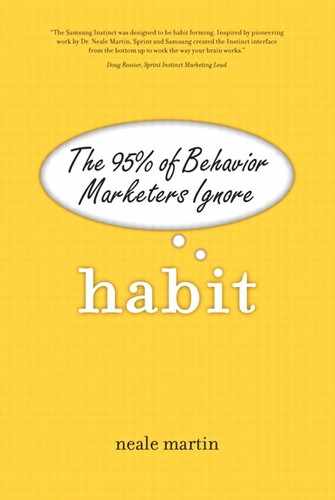Trust the Brand
The brand is the key to successful customer habituation. For customers to automate a purchase or use decision, they must trust the brand. A lack of trust will keep a decision under the control of the executive mind. People might vary widely in their initial willingness to trust, but when a trust is violated, the vast majority will never fully trust the violator again. Conversely, when trust is established, a customer will want to maintain the relationship, resisting overtures by competing brands. Loyalty comes from trust.
A report from the Radiological Society of North America reveals that well-known brands activate positive emotional responses in our brains. These strong activations occur regardless of product category—our brains are conditioned by the brand, not the product. The areas affected are associated with self-identification and rewards.
Customers are not loyal to a brand as they are loyal to a friend or a spouse. Customers do not feel that they are betraying a company by buying a competing brand or shopping at a competitor’s store unless they actually have a friendship with specific people at a company. Customers are loyal to trusted brands because these products simplify their choices. Buying a competing brand means having to engage the executive mind.
To build trust, a company must understand what its brand promises. The brand promise is the deal, the contract between a customer and a company—but it’s an unwritten contract. By consistently delivering on its brand promise, a company can facilitate the transference of a decision from the executive mind to the habitual mind. Brands that lack a clear promise do not create differentiation and fail to gain a stronghold as part of customers’ habitual repertoire.
This shows why the role of the brand in habitual behavior cannot be overstated. The brand is the lynchpin in a customer’s ability to automate a decision. Companies would do well to continuously market their brand identity internally as well as externally. It is not enough for the brand manager to understand a brand’s vision and strategy because decisions made by other managers, marketers, and executives can influence the perception of the brand.
Decisions that impact the brand can come from anywhere, including finance and legal departments. Blockbuster lost $57 million the first quarter after canceling its hated late fees, but the policy was a political nightmare for the company and customers were flocking to Netflix, which doesn’t charge late fees. Wireless carriers are addicted to punitive fees charged to customers who go over their monthly minutes or leave before contract expirations. I have participated in countless discussions with wireless executives defending these policies. From a finance perspective, these decisions seem easy—they generate billions in profits. But the cost is measured in defection rates that cost these same companies billions. Fred Reicheld, a Bain Fellow and founder of Bain’s Loyalty practice, refers to the tactics as creating bad profits.
In relationship businesses, violating a trust is taken personally. When my stockbroker recommended an investment product that I knew would pay him a large commission but was in disfavor with financial planners, it was only a matter of time before I left him. The experience left me feeling angry and betrayed. If I couldn’t trust him, I would have to evaluate every decision and recommendation he made, so why pay him in the first place?
Brands can also suffer when changes are made to products, services, pricing, or distribution channels. Cost-saving decisions that make sense on a spreadsheet can prove disastrous if they violate the customer’s perception of the brand promise. Many companies who have moved customer service offshore have experienced pronounced declines in their ability to deliver acceptable levels of customer service. Similarly, substituting inexpensive components and reducing service levels can break the brand promise.
The brand comes to represent the sum total of a customer’s experience with a product or a company. Sometimes one violation of the brand promise is all it takes, as Nielsen’s Srivatsa points out with baby products that cause a rash. However, habits are persistent, developing their own inertia. When companies reduce the quality of a product or service, we don’t typically see a mass defection. A large majority of customers continue to buy the product pretty much the same way they always have. Losses are usually less than 5% above normal attrition. Anything greater would be a clear indicator that the change was an error, forcing the company to backtrack and fix it.
Our customers’ habitual behavior can mask our mistakes, giving the incorrect impression that cost-cutting decisions that impacted quality were justified. But whether you are a beer maker that found a way to shorten the brewing process or a retail outlet that started charging a restocking fee for returns, you might end up breaking your brand’s promise and cause long-term declines in growth and profitability.
